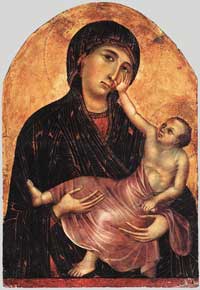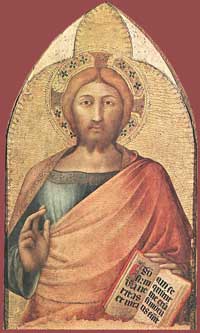Gothic Painting
Northern Gothic Painting
The early Gothic paintings of the Flemish and German artists have a crude and awkward appearance when separated from their original context: the altars and shrines of the cathedrals which they once decorated. Being displayed in a gallery is clearly putting them at a disadvantage. With few exceptions, their purpose and their art can be best valued only within the Cathedral.

Duccio di Buoninsegna
Madonna and Child
Church of Saint Lorenzo and Ippolito
Castelfiorentino
Gothic Stained Glass Painting
The Gothic art of painting was strongly influenced by the architectural characteristics of the period. The Gothic architectural style offered smaller wall surfaces, limited by windows and buttresses, leaving little room for paintings. The splendid stained glass paintings of the Gothic windows were the only form of art able to take the place of the mosaics of the previous era.
Stained glass painting reached perfection, never since rivaled for brilliancy and harmony of color and for technical skills. The revivals of the 19th century, a result of intense study of the Medieval Gothic windows, did not reach the excellence of the old art. It turned out that history and archeology cannot replace the long practice and inherited technical traditions of an entire craft, working all over Europe during the Middle Ages.
The art of the stained glass paintings is revealing that, at this stage, the Gothic painting was similar to the Byzantine mosaics, both in its methods and artistic results. The segments of glass were held together by a framework made of lead. The breaks in the representation of figures could not be avoided, thus the segments were treated in a mosaic style, in larger dimensions. As a result, Gothic figure painting did not evolved much during the period, and was confined to altar and panel pictures.
The most important movements developed in Flanders and Germany, were the School of Cologne, became famous for the richness of colors, elaborate, refined decoration, and excellent narrative skills. By the end of the 14th century, the art of painting gained more importance, and Flanders became one of the two countries where modern painting first developed, the other one being Italy.
Amazingly, not long after, in the first half of the 15th century, the brothers Hubert and Jan Van Eyck produced works which attained technical perfection. Innovators in the study of nature and perspective, replacing tempera with oils, their genius is also revealed by the representation of light, and linear and aerial perspective. Their most important work is the "Adoration of the Lamb" from the Ghent altarpiece.
Panel paintings were considered a subordinate matter, and the majority of them were designed for placement in chapels, churches, shrines, or as altarpieces.
Gothic Italian Painting
The Gothic style Italian painting has its own, distinct character, in connection with the particular architectural characteristics found in the peninsula. Italy preserved the layout of the old basilica, and the Italian Gothic elements are uniquely integrated within this architecture. The wall surfaces are much larger than those of the Northern Gothic Cathedrals, and this fact created the architectural conditions leading to the unique Italian frescoed Gothic.
The Italian painting of the Gothic period is essentially wall painting. Even during the Renaissance, in the 16th century, the most important paintings were done on walls. When canvas and oils were used, as in Venice, the artist still had the wall model in mind, as the canvases were often attached to the walls.

Simone Martini
Blessing Christ
National Museum, Naples
The Gothic fresco painting is Italian par excellence. The artists of Italy developed their skills practising as wall painters. Even the composition of Raphael's Madonnas is the result of the artist's practice as a fresco painter.
The 14th century was the period when the Italian frescoed painting attained perfection.
The greatest painters of the Italian Gothic were Duccio di Buoninsegna of Siena, Giovanni Cimabue and Giotto di Bondone.
Cimabue is distinguished as the first great innovator on Byzantine methods. Duccio's creations, especially in design, may be fairly compared with Giotto's genius, who, with his conception, his wider influence and activity, is the master.
The Italian Gothic painting, with its 14th century frescoes, is a remarkable composition in color , a striking wall decoration revealing the significance of the Bible stories.
With another master, Simone Martini, the Italian Gothic painting is making the transition from Medieval to the beginning of the modern painting.
